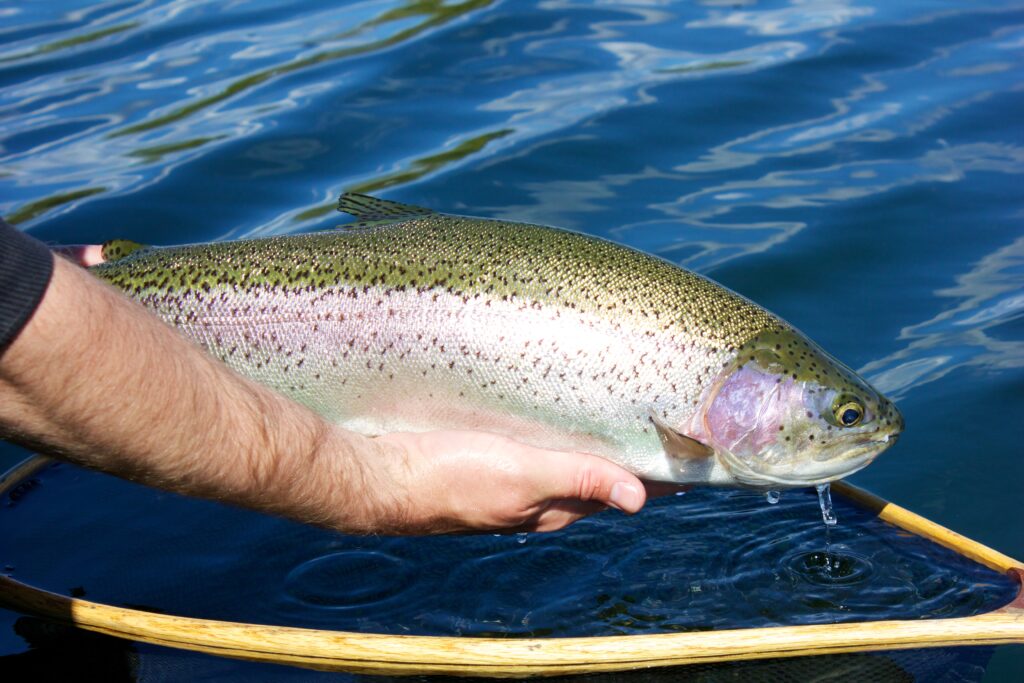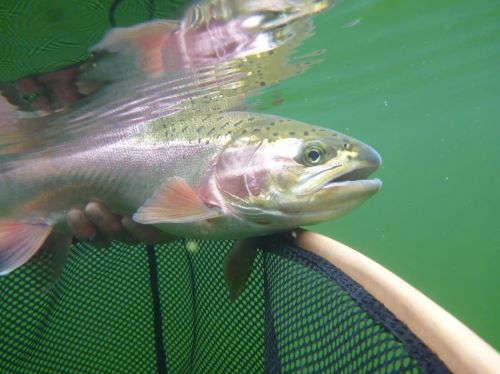Strains of rainbow trout stocked in B.C.
British Columbia is home to a variety of rainbow trout populations that have each become uniquely adapted to their own aquatic environments. The Freshwater Fisheries Society of BC primarily stocks three strains of rainbow trout: two wild (the Blackwater River and Pennask Lake), and one domesticated (the Fraser Valley). However, in recent years we have also added the Horsefly River strain. These strains all have different origins and adaptations. Anecdotal information suggests that not all rainbow trout strains behave the same way, or are caught at the same rate by anglers in small lakes. To help match the qualities of the fish to those desired for a specific fishery, the Freshwater Fisheries Society is investigating the characteristics of strain-specific rainbow trout. Managers of small-lake fisheries can use the diversity within rainbow trout populations to match appropriate strains to specific habitats, improving fish survival and growth – and the fishing!
What we look at when assessing different strains for stocking suitability
Traditionally, growth and survival are the two main traits that researchers measure to determine the suitability of stocking for different lakes. Recently, the Freshwater Fisheries Society has also begun to evaluate catchability (how easy a fish is to catch) and associated traits, like the mortality from catch-and-release. Some strains seem to have very low catchability despite high in-lake survival, which is not desirable for all types of fisheries.
Factors affecting catchability of rainbow trout
Factors affecting catchability are varied, and can include the behaviour of the fish within a lake; how and where they move; and how they react to different fishing gear. Behaviour plays a role after hooking as well, both in the nature of the fight, and in the fish’s resulting stress level. These factors may also affect the trout’s survival if they are released. The ease with which a fish can be hooked and reeled in affects the quality of the angling experience: some anglers want a challenge, while others just want to hook a fish. Knowing what kind of experience anglers want at a given lake, and the catchability of each strain of trout, lake managers can choose to stock fish that will create the desired fishery. Further, if there are differences in catch-and-release mortality between the strains in high-use fisheries, adjusting stocking requests accordingly can maximize fish survival while maintaining angler satisfaction.
Quantifying catchability: Evaluating catch rates
For many years, only anecdotal evidence determined the catchability of strains used in provincial stocking programs; while useful, this didn’t compare different strains and fishing gear used side-by-side. To quantify catchability, the Freshwater Fisheries Society is currently evaluating the differences in catch-rates between multiple strains of rainbow trout within the same lakes. Throughout the spring, summer, and fall, we gather catch information on the strain, length, age, fight duration, and location of fish within a lake, as well as gear type (fly, spincast lure, or lake-troll with bait). Strain-specific mortality rates are also measured for different types of gear, water temperatures, seasons, and lake locations. To ensure that the results are transferrable, two primary lakes are being used: one containing triploid (sterile) fish, and a second with normally reproductive rainbow trout. An earlier Freshwater Fisheries Society trial that compared stress responses to catch-and-release angling within the same lake found that, despite showing similarities in stress levels, triploid fish had higher catch-and-release mortality than normally reproductive fish.


Some strains of rainbow trout are easier to catch
Our researchers are still examining the intricacies of the data, but a few of the main characteristics of each strain are already apparent. Pennask rainbow trout are more vulnerable to fly-fishing than other gear. Blackwater rainbow trout are aggressive, and are caught at a higher rate than Pennask using all types of gear. Catch-and-release mortality is variable, mainly dependent on water temperature, fight-related stress, and gear. Thus far, our study has shown median release-mortality to be around 11%, but it is much higher if the water temperature is above 13 degrees Celcius.
Although there is still much more to discover, one thing is certain: a rainbow isn’t just another rainbow. Our hope is that this research will help managers with their stocking decisions, and provide anglers with information on how to decrease mortality from catch-and-release. Each strain within this species has unique characteristics that distinguish it from the others; the availability of so many strains is what makes fishing for rainbow trout in British Columbia so amazing.
Author: Sara Northrup, Freshwater Fisheries Society of BC
